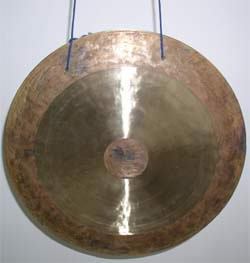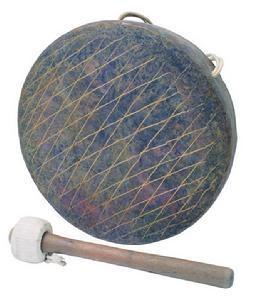The history of the development of the gong
1665 views · Organized by 陌上花 on 2022-02-07
The gong is one of the earliest musical instruments used by the ancient Pu and Luoyue people.
In 1978, a Baiyue gong from the early Western Han Dynasty was unearthed from the Luobowan Tomb No. 1 in Guixian County, Guangxi (called Bushan County in the Qin and Han Dynasties). The gong is 33.4 cm in diameter, and the diameter of the gong’s hilum is 22 cm. There is an arch line pattern cast on the edge of the gong. Three equidistant live rings are tied on the arch string, and the inscription “cloth” is engraved on the surface of the gong.
This is the earliest known gong in China. It can be seen that gongs have a history of more than 2,000 years in my country. With the expansion of the Qin and Han Dynasties, the Baiyue area was included in the territory of China, and the gongs gradually spread to the mainland.
"Old Tang Book·Music Records" states in the article "Tongba": "Tongba, also known as copper plate, goes out of Xixu and Nanman.... The big one in Nanman is a few feet round,..." The number of this circle The "bronze plate" of the ruler is the earliest record of gongs appearing in writing. Chen Yang of the Northern Song Dynasty mentioned the appearance of the gong in the Central Plains in the "Book of Music" and said: "The later Wei began to like the sound of the Hu sound after the declaration of Wu. He moved the capital, ... hit the sand gong." After 515 AD, the general Knocking a small gong is called a sand gong. In ancient times, gongs were often used in ceremonies and wars and were once called "gold". Therefore, there are sayings of "ringing the gong to clear the way" and "ringing the gold to withdraw troops". By the Song Dynasty, gongs were used in the folk music form "guban".
In the Yuan Dynasty, it was also the main accompaniment instrument for Zaju. In "Lan Cai and Zaju", there is a sentence: "hold some... gongs, boards and drums...". In the "Yuan Shi·Rite and Music Records", the cloud (the current cloud gong) is included, and its shape and performance method are described. It is not only used in court banquets, but also popular among the people, which fully explains the manufacture and performance of gongs at that time. Playing already has a certain level.
In 1791, the French composer Gosec began to use the gong in orchestral works.
In the vast urban and rural areas of China, gongs were once used as tools for shoulder-carrying hawkers and monkey jugglers to solicit business along the streets. Since the 20th century, gongs have been widely used by various ethnic groups in folk entertainment, festivals, local opera and folk music, and played by various bands.

In 1978, a Baiyue gong from the early Western Han Dynasty was unearthed from the Luobowan Tomb No. 1 in Guixian County, Guangxi (called Bushan County in the Qin and Han Dynasties). The gong is 33.4 cm in diameter, and the diameter of the gong’s hilum is 22 cm. There is an arch line pattern cast on the edge of the gong. Three equidistant live rings are tied on the arch string, and the inscription “cloth” is engraved on the surface of the gong.
This is the earliest known gong in China. It can be seen that gongs have a history of more than 2,000 years in my country. With the expansion of the Qin and Han Dynasties, the Baiyue area was included in the territory of China, and the gongs gradually spread to the mainland.
"Old Tang Book·Music Records" states in the article "Tongba": "Tongba, also known as copper plate, goes out of Xixu and Nanman.... The big one in Nanman is a few feet round,..." The number of this circle The "bronze plate" of the ruler is the earliest record of gongs appearing in writing. Chen Yang of the Northern Song Dynasty mentioned the appearance of the gong in the Central Plains in the "Book of Music" and said: "The later Wei began to like the sound of the Hu sound after the declaration of Wu. He moved the capital, ... hit the sand gong." After 515 AD, the general Knocking a small gong is called a sand gong. In ancient times, gongs were often used in ceremonies and wars and were once called "gold". Therefore, there are sayings of "ringing the gong to clear the way" and "ringing the gold to withdraw troops". By the Song Dynasty, gongs were used in the folk music form "guban".
In the Yuan Dynasty, it was also the main accompaniment instrument for Zaju. In "Lan Cai and Zaju", there is a sentence: "hold some... gongs, boards and drums...". In the "Yuan Shi·Rite and Music Records", the cloud (the current cloud gong) is included, and its shape and performance method are described. It is not only used in court banquets, but also popular among the people, which fully explains the manufacture and performance of gongs at that time. Playing already has a certain level.
After the Yuan Dynasty, with the development of opera art, it opened up a vast world for the use of gongs. Since the Ming and Qing dynasties, various forms of gongs have been widely used in opera music, dance music and traditional drum music, wind and drum music, gongs and drums.

In 1791, the French composer Gosec began to use the gong in orchestral works.
In the vast urban and rural areas of China, gongs were once used as tools for shoulder-carrying hawkers and monkey jugglers to solicit business along the streets. Since the 20th century, gongs have been widely used by various ethnic groups in folk entertainment, festivals, local opera and folk music, and played by various bands.
Involving musical instruments
The gong is a traditional percussion instrument, also known as the gong because it is made of copper. Different places have different gongs. Wooden gongs, leather gongs, sieve gongs, earth gongs and gongs are all made of copper.
Guess you like
Organized by 拙 on 2022-06-23
In the ancient city of Shouzhou, many gong and drum teams are active, and gong and drum performances are held during the festivals.
read >>
Organized by 一杯清酒 on 2022-06-22
On June 18, the 2022 Xianfeng County Cultural and Natural Heritage Day and the Cultural and Ecological Protection Experimental Zone construction achievements publicity and display activities were held in the Tangya Tusi City Site Scenic Spot.
read >>
Organized by 氯化钠 on 2022-06-21
Getiaogang Township, Changli County, while actively developing beautiful villages, also strives to do a good job in cultural construction, and organizes cultural talents to carry out various forms of cultural and entertainment activities in the spare time after dinner to enrich the spiritual and cultural life of the masses.
read >>
Organized by 八日蝉 on 2022-06-15
"One after another, that mountain comes, one after another of water..." The northern Shaanxi folk song "Shandan Dan Blossoms Red and Bright" played by Yan'an Red Street Internet celebrity "Red Street Rabbit" and local folk singer Zhang Yongwang just opened, and it quickly became popular in the audience. There was a "sound wave" in the live broadcast room.
read >>
Organized by 雨童 on 2022-03-21
Bai folk instrumental music mainly includes sanxian music, suona wind and percussion music, cave scripture music, etc. In addition, there are also ancient music and tunes played by bamboo flute, mouth spring, wood leaf and so on.
read >>
 渝公网安备 50010702504639号
渝公网安备 50010702504639号